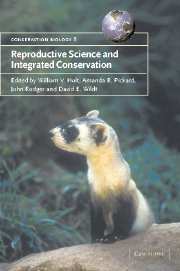Book contents
- Frontmatter
- Contents
- List of contributors
- Foreword
- Part I Introduction
- Part II Reproduction and population viability
- Part III Reproductive techniques for conservation management
- 9 Reproductive and welfare monitoring for the management of ex situ populations
- 10 Non-invasive endocrine measures of reproduction and stress in wild populations
- 11 Ultrasound for analysis of reproductive function in wildlife species
- 12 Role of embryo technologies in genetic management and conservation of wildlife
- 13 Application of nuclear transfer technology to wildlife species
- Part IV Integrated conservation management
- Part V Reproduction science in non-mammalian species
- Part VI Conclusions
- Index
- References
9 - Reproductive and welfare monitoring for the management of ex situ populations
Published online by Cambridge University Press: 21 January 2010
- Frontmatter
- Contents
- List of contributors
- Foreword
- Part I Introduction
- Part II Reproduction and population viability
- Part III Reproductive techniques for conservation management
- 9 Reproductive and welfare monitoring for the management of ex situ populations
- 10 Non-invasive endocrine measures of reproduction and stress in wild populations
- 11 Ultrasound for analysis of reproductive function in wildlife species
- 12 Role of embryo technologies in genetic management and conservation of wildlife
- 13 Application of nuclear transfer technology to wildlife species
- Part IV Integrated conservation management
- Part V Reproduction science in non-mammalian species
- Part VI Conclusions
- Index
- References
Summary
INTRODUCTION
Non-invasive reproductive hormone monitoring methods originated many years ago. Urine-based pregnancy diagnosis methods for humans and livestock species were developed in the 1920s (Cowie, 1948), to measure either gonadotrophins or oestrogens. However, these techniques were noninvasive only for the subject of study and relied on the assessment of physiological changes in other species (usually mice) following injection of the subject's urine. Chemical urinary pregnancy tests followed approximately 10 years later, but at that time were not considered reliable or accurate enough to be routinely used (Cowie, 1948). The advent of specific, immunological tests for identifying and quantifying hormones (Yalow & Berson, 1959) provided new opportunities for reproductive monitoring, allowing the development of the non-invasive techniques used today.
Quantifying hormone concentrations non-invasively has gained popularity within the conservation community over the last 15 to 20 years, as the practical and welfare implications of collecting blood samples from intractable and endangered animals have been recognised. Commonly, steroid hormone metabolite concentrations are measured in excreta, such as urine, faeces, saliva and sweat, by radioimmunoassay or more recently, enzyme immunoassay. In isolation, knowledge of the reproductive status of wild animals in captivity is a useful indicator of individual well-being. However, when integrated with other data it becomes a powerful management tool. As such, predictions about, for example, the outcome of an ex situ conservation programme, the success of an assisted reproduction programme, the point when available resources for housing animals will become limiting, or the impact of the environment on an animal's physiology can be made.
- Type
- Chapter
- Information
- Reproductive Science and Integrated Conservation , pp. 132 - 146Publisher: Cambridge University PressPrint publication year: 2002

